Winter is almost upon us, and if it’s similar to last year, it has the potential of being extremely cold and deadly, especially because of El Niño, said Hector Guerrero, warning and coordination meteorologist with the National Weather Service in San Angelo.
“El Niño Southern Oscillation (ENSO) can impact Texas weather during late fall, winter and the early spring season, or Nov. 2015 through March 2016,” said Guerrero in a presentation Wednesday at the National Weather Service Center in San Angelo, 7654 Knickerbocker Road.
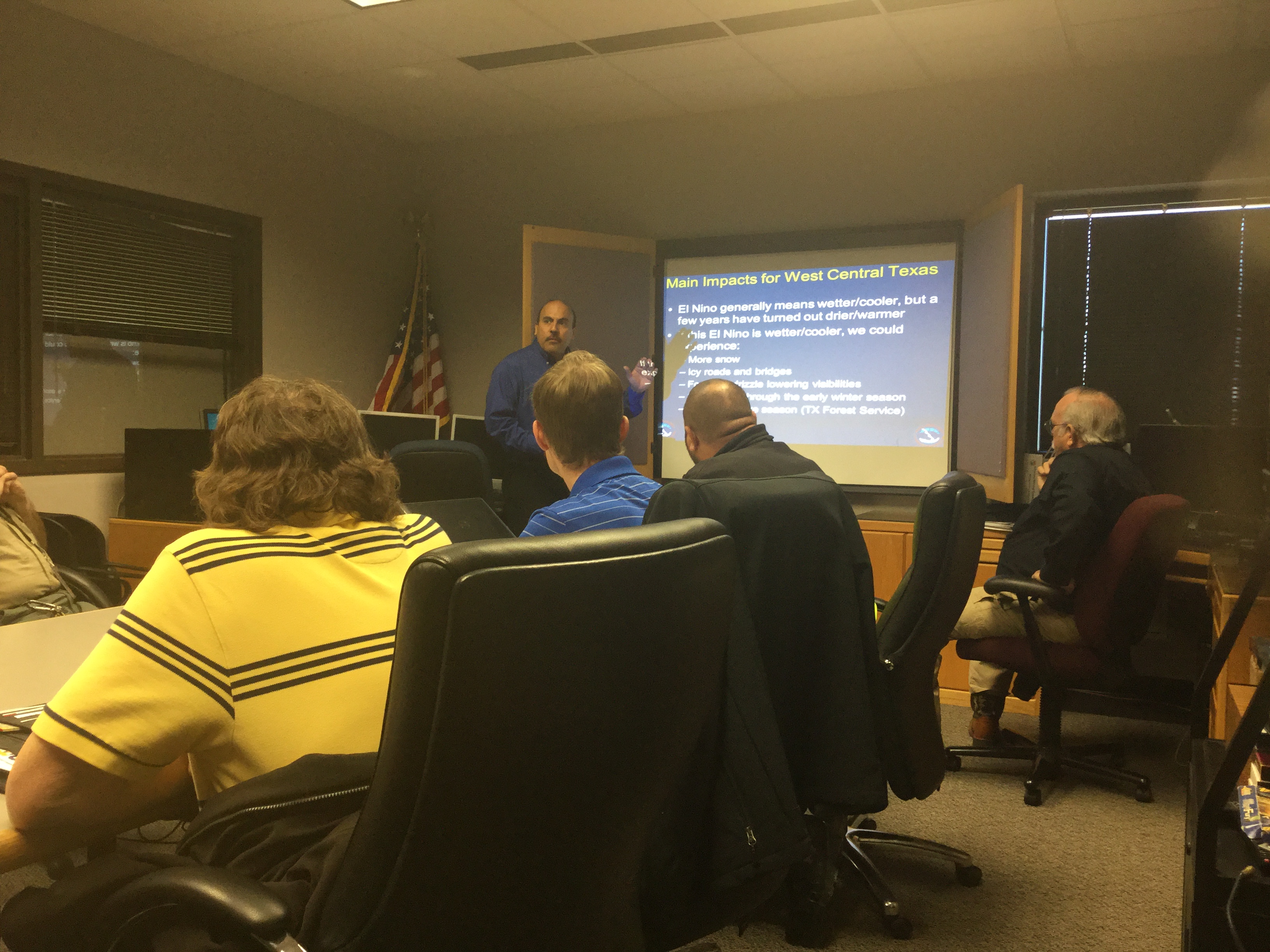
Guerrero, along with experts from the Texas Department of Transportation (TxDOT), San Angelo Police Department, Shannon Hospital, Tom Green County Emergency Management and the Texas Division of Emergency Management gathered in honor of Winter Weather Awareness Day in West Texas to provide imperative information for the media to dispense to the public in preparation for an El Niño Winter. This information is meant to help ease the tragedies and costs that have plagued West Central Texas, or Texas in general.
“El Niño generally means wetter and cooler weather, but a few years have turned out drier and warmer,” Guerrero stated. “We could see icier roads and bridges, along with a lot of fog. I think a lot of cloudy days will affect the people here in San Angelo.”
Guerrero also said the storms may get a lot stronger here in the next month, even tornadoes.
“You never know with El Niño. It makes things unpredictable,” he stated.
Dealing with Winter Road Conditions
Because of the ice and snow patterns in the past few years, along with the tragedies that resulted from wintry road conditions, the Texas Department of Transportation (TxDOT) has been preparing for this winter since August in hopes of alleviating some of the problems. Educating the public is part of that preparation.
Karen Threlkeld with the agency said TxDOT is the 2nd largest in the U.S behind California. “We have over 80,000 miles of road we cover. In our district alone, we have over 3,000 miles,” Threlkeld explained.

Above: Karen Threlkeld with TxDOT discusses winter road conditions. (LIVE! Photo/Brandy Ramirez)
To prepare for another cold year, TxDOT has started preparing all its equipment to ensure everything is working properly and has been cleaned. The agency is also using new brine materials on the road to help pretreat them to prepare for icy road conditions and for storms.
At this time, TxDOT has 125 maintenance personnel throughout the 15-county district to get the roads ready.
Threlkeld stated, “We’ve got about 80 pieces of equipment right now that are prepared with the brine spreader boxes, the brine makers strategically placed in areas, so we’re going to be more prepared this year than perhaps we were last year."
The TxDOT representative said in 2014, the agency spent $568,000 on ice and snow removal just here in “our district.” Previously, that amount was $605,000 per year. Last year, for the entire state of Texas, TxDOT spent $29 million on ice and snow removal.
"The last two years have really been pretty hard on us,” Threlkeld claimed.
The presenter added that winter weather brings havoc on the traveling public. In fact, several of TxDOT’s own vehicles were in crashes in the previous years; no one was hurt.
“When weather happens, people tend to drive not to conditions, and that’s one reason why we say, “Ice and snow, drive slow.’"
Threlkeld also said just because there’s a posted speed limit, that doesn’t mean people will follow it. As a result, many crashes have occurred because people failed to take precautions while driving in sleet, snow or hail.
According to handout provided by Threlkeld and TxDOT, from Dec. 1, 2013 to May, 1, 2014, there were 5,327 crashes in the San Angelo District. Out of that number, 17 were fatalities. From Dec. 1, 2014 to May 1, 2015, there were 4,776 crashes and 22 fatalities.
“There are probably a lot more that law enforcement haven’t reported," stated Threlkheld.
Overall, in Texas, there were over 4,800 deaths reported last year.
Threlkheld said to help drivers during adverse weather conditions, DriveTexas.org is one of the best resources for drivers to get up-to-date road condition information any time of the year. People can also look at construction projects and crashes.
“Information is directly coming from maintenance offices, people who are on the ground; and they’re inputting this information in the system,” Threlkheld explained.
People can also follow TxDOT on Twitter, which also has the most up-to-date information on road conditions.
“Social media has been really big for us in a lot of areas,” Threlkheld noted.
TxDOT Workers on the Road
Jerry Stone, a Tom Green County maintenance section assistant, gave a Winter Weather Equipment demonstration Wednesday as well to explain what maintenance workers deal with on the roads in the 15-county district.
“This last winter, TxDOT as a whole switched gears,” Stone said. “We had been using a chemical called Apex, which is a calcium chloride for the last several years.”
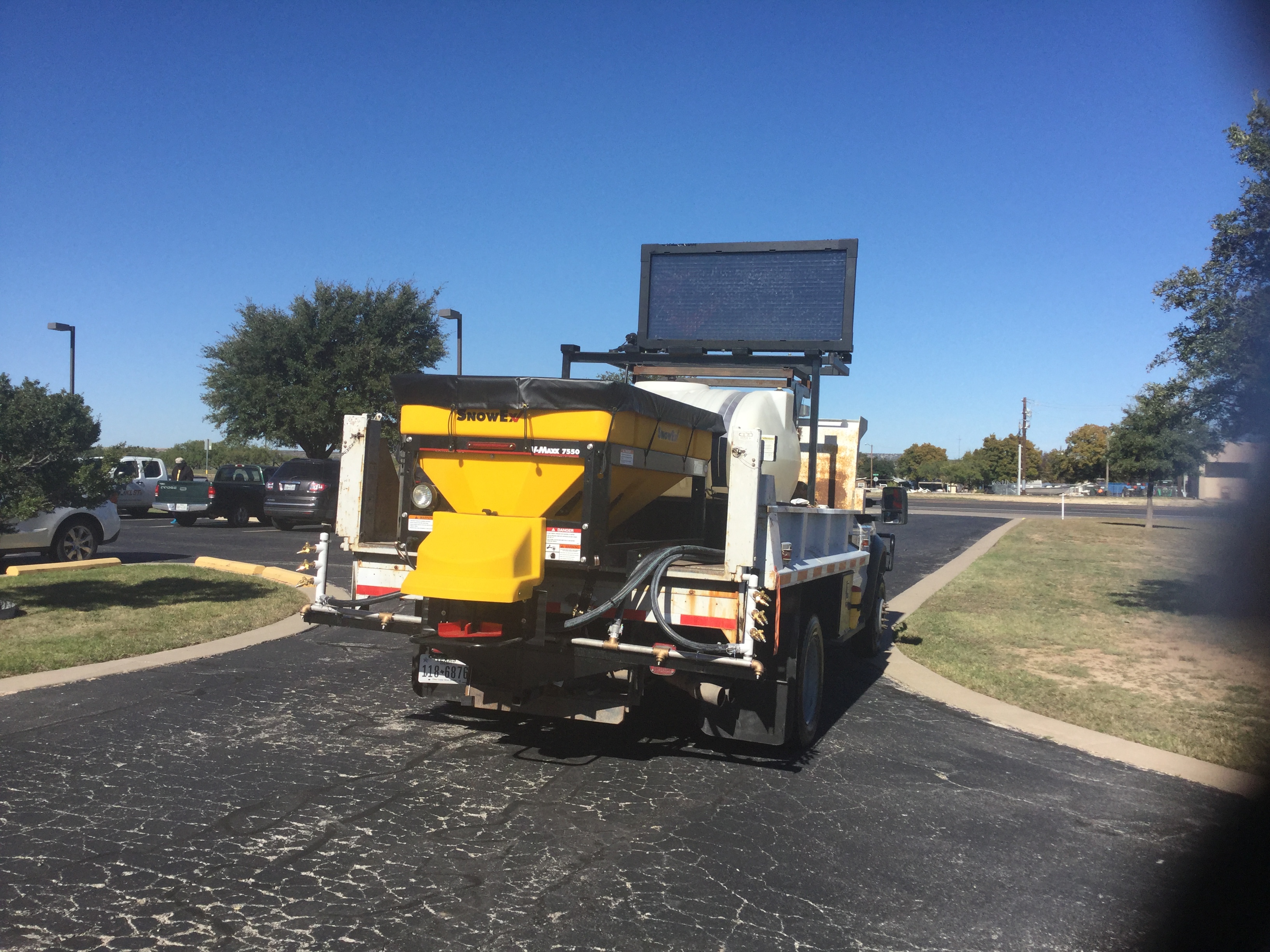
Above: This is the truck TxDOT workers use to pre-treat the roads with brine. (LIVE! Photo/Brandy Ramirez)
However, that chemical only allowed the workers to treat certain areas, so this year, TxDOT switched to brine as previously explained. Stone said this is salt water that allows them to treat the roadway as a whole. Plus, it’s more cost effective.
“The brine cost us about $.14 a gallon compared to the liquid calcium chloride, which usually cost us $2.80 a gallon, so the comparison is a huge margin,” Stone explained.
Stone added that he works the night shift, and that’s when the worst weather climates hit and when the vehicle accidents happen.
Therefore, Stone asked that the public be aware of what’s taking place, not only in their own vehicles, but when coming upon TxDOT workers who are pre-treating or treating the roadways.
“If you see one of our units out on the roadway during the pre-treating, give it room,” he said. “Just give us an opportunity to do our job.”
Driving Safely During the Winter
Sgt. Todd Dornhecker with the SAPD also gave his take on winter driving safety and precautions people should adhere to during wintry weather conditions, especially to avoid what happened last year.
“We had 108 wrecks documented in one day with that one ice storm last year,” Dornhecker stated. “I can remember a fire truck sliding down the bridge over 7th and Bryant. That’s something you want to get out of the way of."
Thus, Dornhecker had some advice to give the public.
“We often see people warming their cars up,” Dornhecker said. “We obviously don’t want to start our cars and warm them in the garage where carbon monoxide can be an issue. We want to make sure windshields are clear from obstructions”
The sergeant also stated for drivers do stay off the road if they don’t have to be out; however, if they do, they’ll want to make sure their car has enough fuel and general maintenance done do it, including making sure the defroster is working properly and driving within a safe distance. Drivers should provide an 8-second distance between vehicles.
“It gives you time to stop,” Dornhecker noted.
Additionally, if a driver has non anti-lock brakes, they’ll want to pump them to slow down. With anti-lock breaks, drivers want to apply pressure. Also, should the vehicle go into a spin, drivers want to ease up on the accelerator.
“You don’t try to accelerate through a spin. The rear ends going to turn into the front end at some point,” stated Dornhecker.
He also said to steer into the direction of the skid. “Steer where you want the front of the vehicle to go while you’re off the accelerator,” the officer said.
Dornhecker finalized by stating drivers should avoid bridges, and plan a different route if they have to be on the roads. Drivers should also wear their seatbelts and have kids in their car seats or restraints.
Staying Healthy in the Winter
Leisa Clayton, FNP, with Shannon Hospital said there are three Fs associated with winter: falls, frostbite and flu.
Falls, unfortunately, don’t end well, especially for people who work in construction or in the oil field.
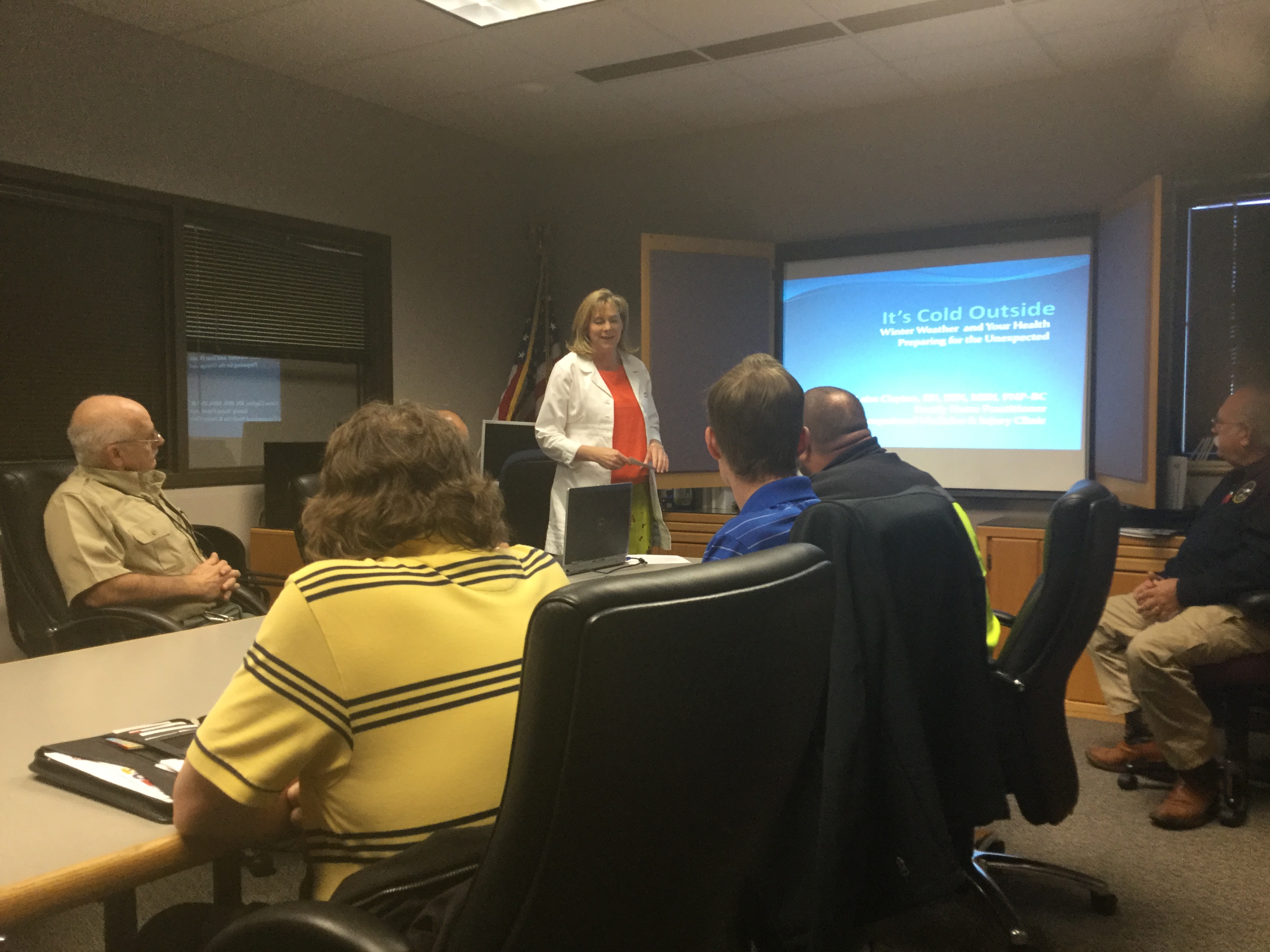
Above: Leisa Clayton, FNP for Shannon, talks winter health. (LIVE! Photo/Brandy Ramirez)
“We have a lot more fatalities, and this is separate from the motor vehicle fatalities. This is just falls,” Clayton said. “In 2014, there were 67 deaths related to falls in Texas. Sixty-four were male; 34 were ages 45 to 65 years old, and 39 worked in construction.”
Therefore, Clayton said people who have to be working out in the cold should do their best to pay attention to weather advisories, wait to do things when there’s ice, “light it up,” remove hazards and use assisted devices. This same advice goes for frostbite as well.
More importantly, get a flu shot, Clayton added.
“Influenza viruses love the cold,” she stated.
Final Words of Wisdom
Other experts who spoke Wednesday were Steve Mild with San Angelo and Tom Green County Emergency Management and Jerry Huffman with the Texas Division of Emergency Management. Mild discussed winter home safety while Huffman addressed winter weather fire safety.
Mild said, “Always get your heater serviced before turning it on.”
Many times, people who don’t do so may have something near the heater that can cause a fire, including a dirty filter.
“Make sure to change those filters every 30 days,” Mild added.
In addition to Mild’s suggestions, other tips are posted below to help San Angeloans and West Texans in the surrounding areas to help avoid tragedies and lower the costs associated with ice and snow.
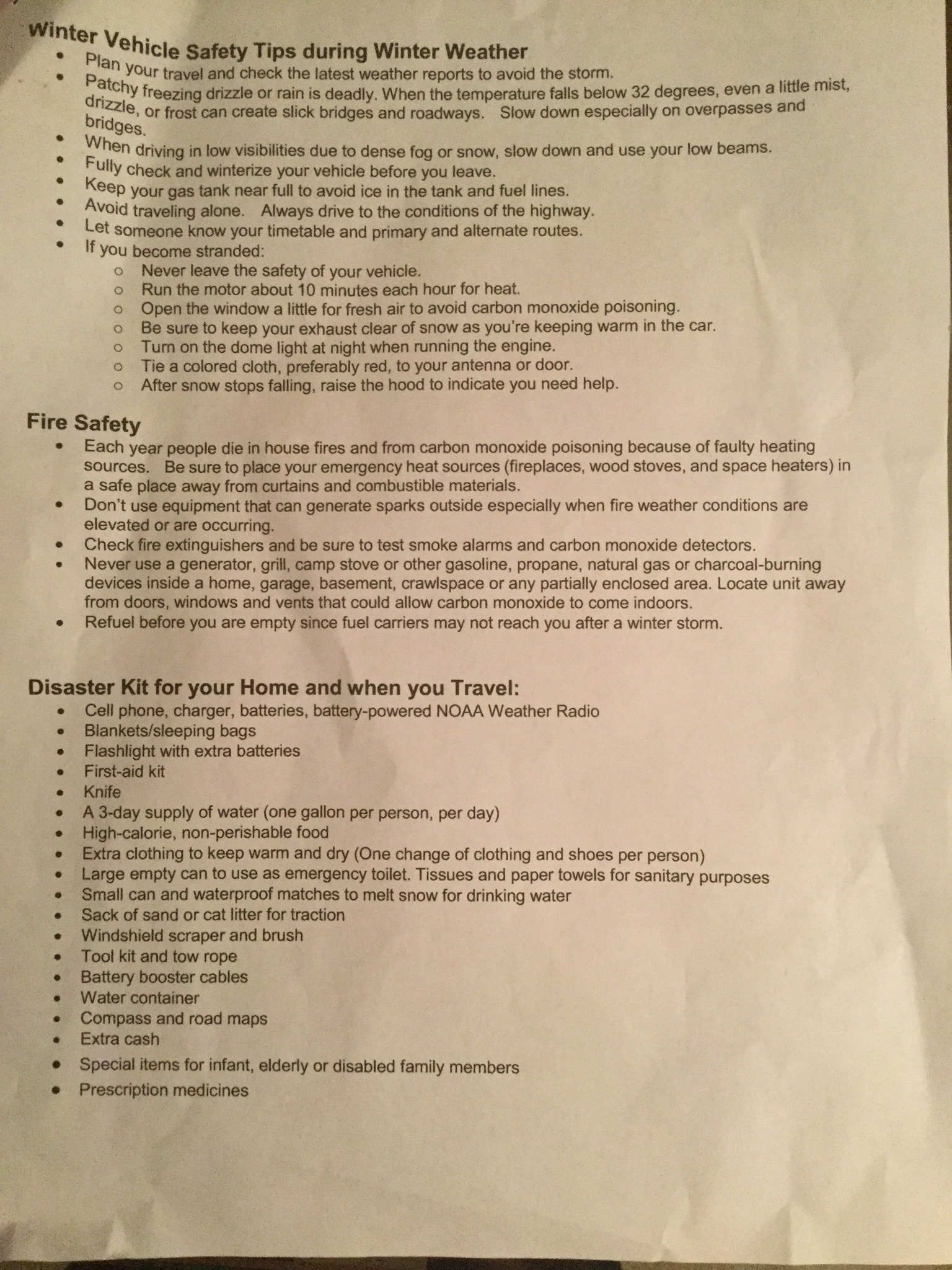
For more information on winter weather safety, visit the following links:
Subscribe to the LIVE! Daily
Required



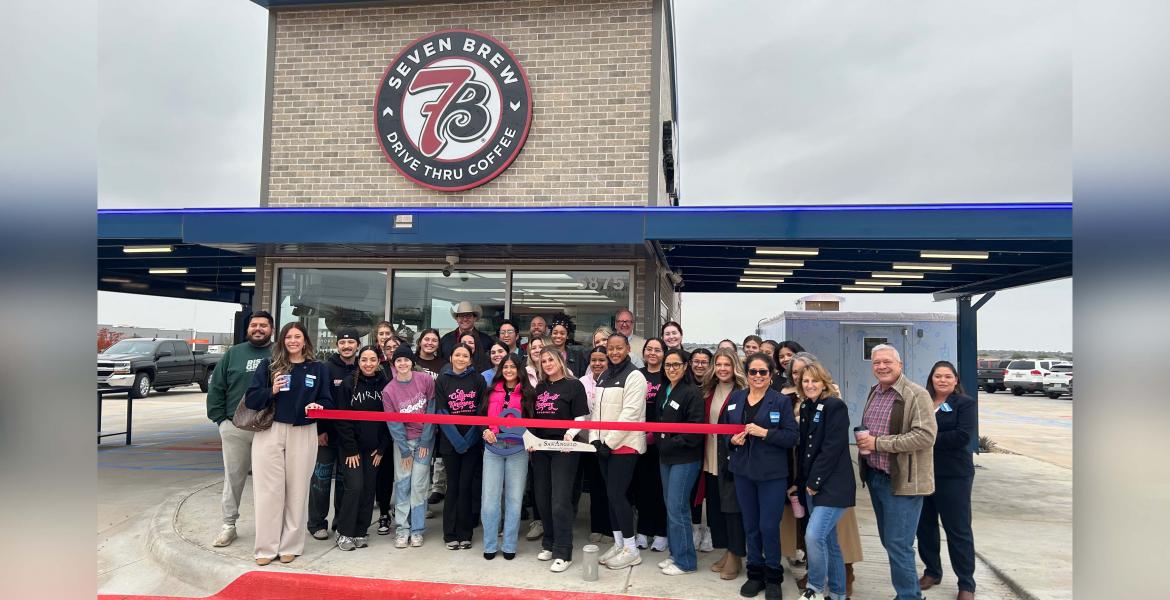
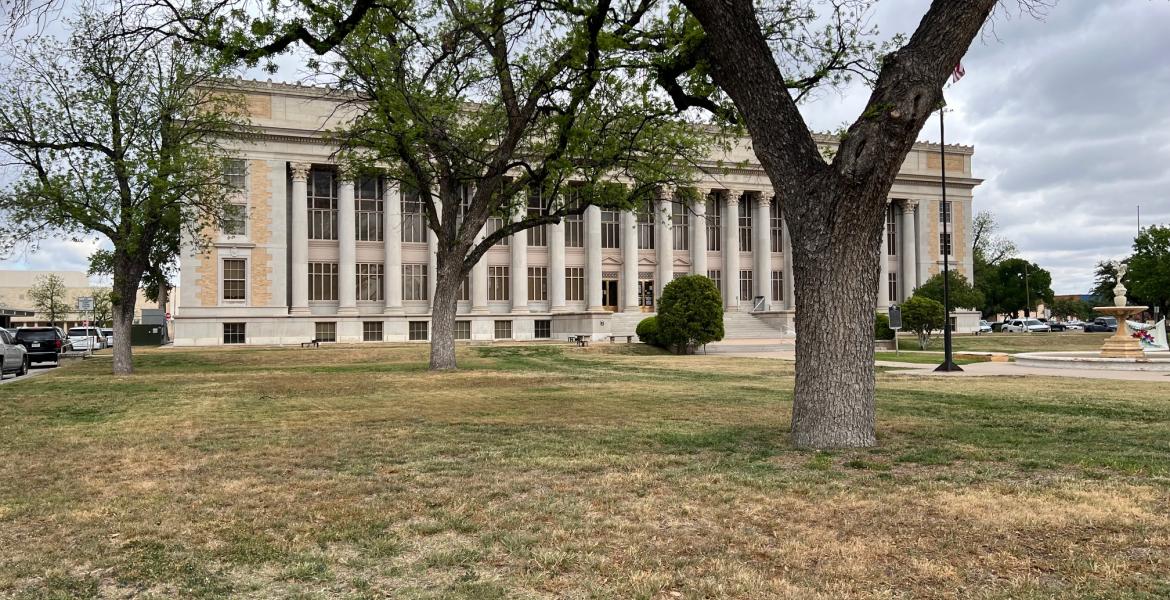

Post a comment to this article here: